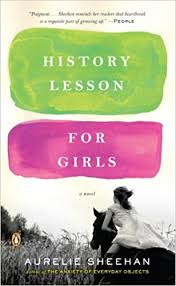
History Lesson for Girls is not a history book, despite the impression you might get when you first read the title. This is not a work of historical fiction either. Yet, history plays a big part in this book.
This is also not a book for little girls. Some more mature teens might be able to read it, despite all the drug references, but, for reasons I will explain later, I’m not sure they would relate to it very well. No, this is a book written for grown women, despite the main character describing her tumultuous year as a seventh grader.
Allison Glass, now an adult and a veterinarian, thinks back to when she was thirteen-years-old. The year was 1975. Her parents (whose marriage is starting to crumble) just moved into a new house in a new town. This left poor Allison stuck starting a new school year in a new school where she had no friends.
What is worse, is that this she is about to start seventh grade, an awkward and tense school year that no one I know of enjoyed. What is tragic is that Allison has just been diagnosed with scoliosis, and will be starting this most difficult of school years wearing a large metal and plastic brace that covers her entire back and extends to her neck. There isn’t any way to hide it. She is doomed to be “the girl in the brace”.
What saves Allison is her new friend, Kate, who rides up to her on horseback slightly before the school year starts. Each girl owns a horse, and loves to ride, and the two of them hit it off and become very close.
Women who read this book will think back to their own middle school friends, and wonder whatever became of them. Much of this book is about what it means to be a friend, how important it is to have a best friend, and how incredibly intense friendships are when you are thirteen-years-old.
History plays a big part in this story. The girls (when they aren’t riding their horses) are working on a project for their history class that will be presented in May of 1976.
The guidelines for this project are as vague yet important sounding as many of the school projects I remember receiving in the late 1970’s and early 1980’s. All the girls were certain of was that the project must have something to do with the history of the town.
So, they create a “lost heroine”, and take turns writing her story, squeezing in the little facts and details along the way. Each chapter in History Lesson for Girls begins with a few paragraphs from the lost heroine’s diary.
I thought the girls came up with a very creative idea, but, this was the 70’s, the era in which dioramas were considered to be the absolute pinnacle of educational forms of display. As such, the girls didn’t get very high marks on their work. That doesn’t matter to them, though. By then, way too many other, much larger tragedies had happened.
Anyone who is old enough to have lived through the early 1970’s will recall how patriotic we all were back in 1976. It was America’s bicentennial, after all, and the world was very red, white, and blue. I had forgotten how festive that all felt.
It’s not like now, where flags are displayed, but tied into the thoughts of our troops fighting a war that a growing number of Americans don’t want. It was a much happier representation of patriotism back then, without all the fear that is mixed into it today.
Sheehan captures the 70’s so well it’s like walking right back into it. Orange shag carpet, and “wings” in our hair. Smoking still acceptable in restaurants. Ashtrays on people’s living room coffee tables, and a general unspoken acknowledgment that many teens smoked cigarettes. Everyone agreed that smoking cigarettes was not good for you, but, with “Smoking Stinks” campaigns not getting started until sometime around the late 70’s, people were not into hassling other people about smoking just yet.
Phones that had cords attaching the handset to the base, with one “ring tone” available, and no caller I.D. or voice mail options. No cell phones. None of that existed yet. I am not at all certain that teenagers who read this book will be anywhere near as excited by all of this as I was. For me, it was “Hey, I remember that!”. They are too young to remember that.
Another thing I remember about the 70’s that Sheehan includes is the general attitude that teens were basically smaller adults. I mentioned that teens smoked, and no one really thought much of it. Kate’s parents drink and allow their teenagers to drink alcohol. They allow Allison to drink along with them. It was acceptable for teens to come into bars and hang around if their parents were attending a party in that bar that night.
Kate’s parents are very up front about discussing sexuality with whoever is listening, and that includes Kate and Allison. No one really is concerned if the teens are having sex, despite them being only thirteen. Kate finds herself, more than once, hit on by some of her parent’s adult male friends.
In addition to drinking and smoking, Kate’s parents (whose marriage is crashing down around them) smoke pot, and do cocaine, sometimes while drinking, and always in front of their kids. No one is the slightest bit worried about having the police called. It was a different time.
Those of us who remember what the 70’s were like will find this book nostalgic. I think that anyone too young might just see this book as one big scandal after another, and miss out on the actual story. Would teens today even recognize the music that Allison and Kate groove to?
Allison’s parents, on the other hand, are very “New Age”, when “New Age” itself was new. Much of this is a desperate attempt to try anything and everything to fix Allison’s back, and avoid the surgery she might need if the brace doesn’t do a good enough job of correcting her crooked spine.
They try faith healers, yoga, strange health foods, swimming lessons, and whatever else they come across. Her mom is an artist, and her dad is a poet who enjoys meditation. They were very ready for the New Age movement. Will all of this effort work? Allison hopes so, but is skeptical, as most seventh graders are by nature.
What makes her more skeptical is that she doesn’t see much difference in the yoga instructors and faith healers than she does in Kate’s father, a man who has changed his first name to “Tut”. He has written a book that bastardizes ideas from many different cultures, including Egyptian, and basically is encouraging people to live their lives only doing what makes them happy. He doesn’t care about how that way of living affects people’s loved ones – and doesn’t appear to be aware that there could be negative consequences.
Things take a turn for the worse in a number of ways, and the story gets moving pretty fast. This was a time period where divorce was still something people gossiped about, and affairs were completely devastating. Allison and Kate find their families lives entwined, and not in a good way. By the end, we are left with a series of tragedies, and the grown up Allison, still affected by it all.
It’s a serious book, and one that immerses you in the story, if you are the right age to read it. It’s not a light and airy “summer read”, but instead, a deep dive into the past.
This book review of History Lesson for Girls – by Aurelie Sheehan is a post written by Jen Thorpe on Book of Jen and is not allowed to be copied to other sites.
If you enjoyed this blog post please consider supporting me on Ko-fi. Thank you!
